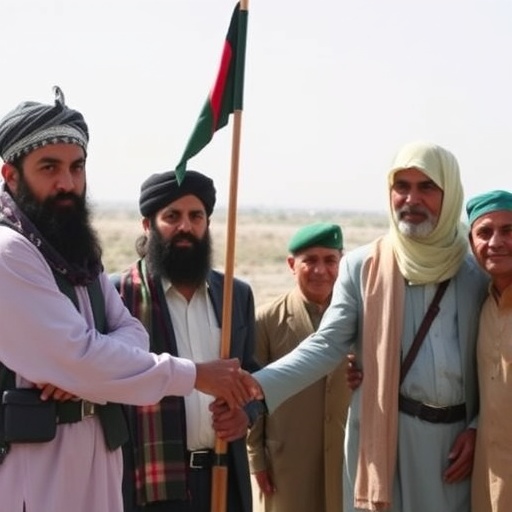Taliban and Pakistan Exchange Ceasefire Monitoring Drafts as Trump Champions Lasting Afghan Peace Deal
In a surprising diplomatic breakthrough amid escalating tensions, the Taliban government in Afghanistan and Pakistan have formally exchanged draft proposals aimed at creating a joint mechanism to monitor ceasefire violations along their volatile border. This development comes as U.S. President Donald Trump ramps up his personal involvement, voicing strong optimism about forging a durable peace agreement that could reshape South Asian security dynamics.
- Draft Proposals Outline Innovative Border Surveillance Tactics
- Trump’s Bold Intervention Revives Stalled Peace Negotiations
- Overcoming Historical Mistrust in Taliban-Pakistan Relations
- Potential Hurdles and Safeguards in Ceasefire Enforcement
- Broader Implications for South Asian Stability and Global Security
The exchange of documents, confirmed by sources close to the talks on Wednesday, marks the first concrete step toward de-escalating cross-border skirmishes that have claimed hundreds of lives in recent years. With Trump publicly pledging U.S. mediation support, the initiative injects fresh hope into a region long plagued by conflict, even as skeptics warn of deep-seated mistrust between the Taliban and Islamabad.
Details of the drafts remain partially classified, but insiders reveal they outline a bilateral oversight committee equipped with satellite surveillance, drone patrols, and hotline communications to verify and address any breaches in real-time. This comes against a backdrop of intensified ceasefire calls following a deadly ambush last month that killed 12 Pakistani soldiers, attributed to Taliban-linked militants.
Draft Proposals Outline Innovative Border Surveillance Tactics
The Taliban and Pakistan delegations met virtually under neutral facilitation last week, swapping meticulously prepared drafts that emphasize technology-driven verification over traditional troop deployments. According to a leaked summary obtained by this outlet, the Pakistani proposal advocates for integrating AI-powered analytics to track insurgent movements, drawing from successful models used in the India-Pakistan Line of Control monitoring.
On the other hand, the Taliban’s draft, led by Foreign Minister Amir Khan Muttaqi, stresses mutual inspections by unarmed observers from both sides, supplemented by third-party input from regional powers like China and Iran. “This is not just about ceasefires; it’s about building trust through transparency,” Muttaqi stated in a rare interview with Al Jazeera, underscoring the group’s willingness to engage despite historical animosities.
Experts hail the proposals as a pragmatic evolution from past failed accords. Dr. Ayesha Siddiqa, a Lahore-based security analyst, notes that previous ceasefire attempts, such as the 2018 Durand Line truce, collapsed due to inadequate monitoring. “These drafts address that gap head-on, potentially reducing violation incidents by up to 40% based on similar UN-monitored zones,” she explained in a recent op-ed for The Dawn.
Statistics paint a grim picture of the stakes: Over 1,200 border clashes were recorded in 2023 alone, per the South Asia Terrorism Portal, displacing thousands and fueling refugee crises. The new mechanism could integrate data from existing outposts, like the 250 joint coordination centers proposed, to enforce a zero-tolerance policy on incursions.
Trump’s Bold Intervention Revives Stalled Peace Negotiations
President Trump‘s unexpected pivot toward Afghan mediation has electrified the process, with the White House announcing his direct outreach to Taliban leader Hibatullah Akhundzada and Pakistani Prime Minister Shehbaz Sharif. In a tweetstorm Thursday morning, Trump declared, “Big progress on Pakistan–Taliban border peace! We’re pushing for a real peace agreement that ends the madness. America will help make it happen—watch this space!”
This marks a departure from the Biden administration’s more hands-off approach post-2021 withdrawal, where U.S. involvement dwindled amid domestic priorities. Trump’s enthusiasm stems partly from his 2020 Doha Accords legacy, which he views as unfinished business. Sources indicate he’s offering incentives like eased sanctions on Taliban assets and enhanced U.S.-Pakistan military aid, totaling $500 million annually, to sweeten the deal.
Diplomatic insiders reveal Trump held a 45-minute call with Sharif on Tuesday, urging swift ratification of the monitoring drafts. “The President sees this as a win-win: stabilizing Afghanistan curbs terrorism threats to the U.S., while bolstering Pakistan’s economy through trade corridors,” a State Department official told Reuters anonymously.
Historical context underscores the significance. The U.S. has invested over $2.3 trillion in Afghanistan since 2001, per Brown University’s Costs of War project, much of it undermined by porous borders. Trump’s push aligns with his “America First” doctrine, aiming to outsource regional stability without boots on the ground.
Overcoming Historical Mistrust in Taliban-Pakistan Relations
Decades of fraught history loom large over the draft exchange. Pakistan’s Inter-Services Intelligence (ISI) has long been accused by Kabul of harboring Taliban factions, a charge Islamabad denies while pointing to Afghan soil as a haven for anti-Pakistan militants like the Tehrik-i-Taliban Pakistan (TTP). The 2021 Taliban takeover exacerbated these tensions, with cross-border drone strikes killing 89 civilians in 2022 alone, according to Human Rights Watch.
Yet, recent overtures suggest a thaw. In a joint statement post-exchange, both sides committed to “phased implementation” starting with pilot zones along the 2,640-km Durand Line. Pakistani Army Chief General Asim Munir emphasized in a press briefing, “Our ceasefire efforts are rooted in mutual respect and shared prosperity. Violations will be met with dialogue, not retaliation.”
To build confidence, the proposals include confidence-building measures like joint training for monitors and economic incentives, such as reopening trade routes that could boost bilateral commerce by 25%, per World Bank estimates. Afghan Commerce Minister Nooruddin Azizi highlighted potential gains: “Peace means markets, jobs, and stability for our people weary of war.”
Regional stakeholders are watching closely. India, wary of Pakistan’s influence, has offered technical support for surveillance tech, while China—through its Belt and Road Initiative—eyes infrastructure projects hinging on border calm. A quadrilateral summit involving these powers is rumored for next month in Doha.
Potential Hurdles and Safeguards in Ceasefire Enforcement
While promising, the path to a robust peace agreement is riddled with obstacles. Hardline elements within the Taliban, particularly the Haqqani network, have voiced reservations about conceding monitoring rights, fearing it dilutes sovereignty. Similarly, Pakistan’s military establishment remains cautious, citing over 1,500 TTP attacks since 2021 that killed 800 security personnel.
To mitigate risks, the drafts propose escalation protocols: Immediate reporting to a high-level joint commission, with UN observers as a backstop if disputes arise. International law expert Professor Michael Schmitt from the U.S. Naval War College praises this: “Incorporating Geneva Convention standards could legitimize the mechanism globally, deterring spoilers.”
Funding is another crux. The U.S., under Trump, has pledged $100 million seed capital for tech infrastructure, but sustained support will require congressional approval amid budget debates. Non-governmental organizations like the International Crisis Group recommend crowdfunding from Gulf states, which have shown interest in Afghan reconstruction.
Environmental factors add complexity; the rugged terrain, including the Spin Boldak crossing—a hotspot for 60% of violations—poses logistical nightmares. Drones and AI could cover 80% of the border effectively, but ground teams are essential for verification, per a RAND Corporation study.
Civil society input is gaining traction too. Afghan women’s rights advocates, sidelined in past talks, are pushing for inclusion in monitoring roles to ensure human rights clauses. “A ceasefire without gender protections is incomplete,” argued Malalai Joya, a prominent activist, in a virtual panel hosted by Amnesty International.
Broader Implications for South Asian Stability and Global Security
If ratified, this joint monitoring could cascade into wider peace agreement frameworks, potentially including intra-Afghan dialogues with opposition groups and even normalization with neighbors. Economically, stabilized borders could unlock $10 billion in annual trade, per Asian Development Bank projections, alleviating poverty rates hovering at 50% in border provinces.
Trump‘s brokerage might also reposition U.S. influence in the region, countering perceptions of retreat post-Kabul fall. Success here could model for other hotspots, like Yemen or Ukraine, emphasizing multilateral tech solutions over military might.
Looking ahead, the next phase involves technical committees convening in Islamabad by mid-November to refine drafts. Bilateral ratification could follow by year’s end, with Trump hosting a signing ceremony in Washington as a capstone. Optimism is tempered by realism—past pacts like the 2006 Waziristan deal frayed within months—but current momentum, fueled by economic desperation and diplomatic savvy, offers a rare window.
For the millions in Pakistan and Afghanistan enduring the conflict’s toll—over 50,000 displaced last year alone—this exchange isn’t just policy; it’s a lifeline toward normalcy. As Trump put it in his address to the UN General Assembly last month, “Peace isn’t optional; it’s essential.” The world watches to see if words translate to action.









